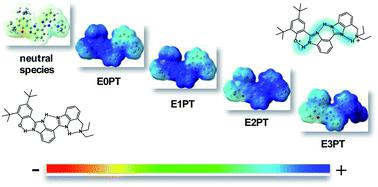当前位置:
X-MOL 学术
›
Chem. Sci.
›
论文详情
Our official English website, www.x-mol.net, welcomes your
feedback! (Note: you will need to create a separate account there.)
Proton-coupled electron transfer across benzimidazole bridges in bioinspired proton wires
Chemical Science ( IF 7.6 ) Pub Date : 2020-03-20 , DOI: 10.1039/c9sc06010c Emmanuel Odella 1, 2, 3, 4 , S. Jimena Mora 1, 2, 3, 4 , Brian L. Wadsworth 1, 2, 3, 4 , Joshua J. Goings 4, 5, 6, 7 , Miguel A. Gervaldo 8, 9, 10, 11, 12 , Leonides E. Sereno 8, 9, 10, 11, 12 , Thomas L. Groy 1, 2, 3, 4 , Devens Gust 1, 2, 3, 4 , Thomas A. Moore 1, 2, 3, 4 , Gary F. Moore 1, 2, 3, 4 , Sharon Hammes-Schiffer 4, 5, 6, 7 , Ana L. Moore 1, 2, 3, 4
Chemical Science ( IF 7.6 ) Pub Date : 2020-03-20 , DOI: 10.1039/c9sc06010c Emmanuel Odella 1, 2, 3, 4 , S. Jimena Mora 1, 2, 3, 4 , Brian L. Wadsworth 1, 2, 3, 4 , Joshua J. Goings 4, 5, 6, 7 , Miguel A. Gervaldo 8, 9, 10, 11, 12 , Leonides E. Sereno 8, 9, 10, 11, 12 , Thomas L. Groy 1, 2, 3, 4 , Devens Gust 1, 2, 3, 4 , Thomas A. Moore 1, 2, 3, 4 , Gary F. Moore 1, 2, 3, 4 , Sharon Hammes-Schiffer 4, 5, 6, 7 , Ana L. Moore 1, 2, 3, 4
Affiliation

|
Designing molecular platforms for controlling proton and electron movement in artificial photosynthetic systems is crucial to efficient catalysis and solar energy conversion. The transfer of both protons and electrons during a reaction is known as proton-coupled electron transfer (PCET) and is used by nature in myriad ways to provide low overpotential pathways for redox reactions and redox leveling, as well as to generate bioenergetic proton currents. Herein, we describe theoretical and electrochemical studies of a series of bioinspired benzimidazole-phenol (BIP) derivatives and a series of dibenzimidazole-phenol (BI2P) analogs with each series bearing the same set of terminal proton-accepting (TPA) groups. The set of TPAs spans more than 6 pKa units. These compounds have been designed to explore the role of the bridging benzimidazole(s) in a one-electron oxidation process coupled to intramolecular proton translocation across either two (the BIP series) or three (the BI2P series) acid/base sites. These molecular constructs feature an electrochemically active phenol connected to the TPA group through a benzimidazole-based bridge, which together with the phenol and TPA group form a covalent framework supporting a Grotthuss-type hydrogen-bonded network. Infrared spectroelectrochemistry demonstrates that upon oxidation of the phenol, protons translocate across this well-defined hydrogen-bonded network to a TPA group. The experimental data show the benzimidazole bridges are non-innocent participants in the PCET process in that the addition of each benzimidazole unit lowers the redox potential of the phenoxyl radical/phenol couple by 60 mV, regardless of the nature of the TPA group. Using a series of hypothetical thermodynamic steps, density functional theory calculations correctly predicted the dependence of the redox potential of the phenoxyl radical/phenol couple on the nature of the final protonated species and provided insight into the thermodynamic role of dibenzimidazole units in the PCET process. This information is crucial for developing molecular “dry proton wires” with these moieties, which can transfer protons via a Grotthuss-type mechanism over long distances without the intervention of water molecules.
中文翻译:

生物启发质子线中跨苯并咪唑桥的质子偶联电子转移
设计用于控制人造光合作用系统中质子和电子运动的分子平台对于有效催化和太阳能转化至关重要。反应过程中质子和电子的转移被称为质子耦合电子转移(PCET),自然界以多种方式使用它为氧化还原反应和氧化还原水平提供低超电势通路,并产生生物能质子流。在这里,我们描述了一系列生物启发的苯并咪唑-苯酚(BIP)衍生物和一系列苯二并咪唑-苯酚(BI 2 P)类似物的理论和电化学研究,每个系列均带有相同的一组末端质子接受(TPA)基团。TPA的范围超过6 p K a单位。设计这些化合物的目的是探讨桥联苯并咪唑在单电子氧化过程中与分子内质子跨两个(BIP系列)或三个(BI 2)转移相关的作用。P系列)酸/碱位。这些分子结构的特征是通过苯并咪唑基桥连接到TPA基团的电化学活性酚,该苯酚与苯酚和TPA基团一起形成支撑Grotthuss型氢键网络的共价骨架。红外光谱电化学表明,苯酚氧化后,质子穿过这个定义明确的氢键网络转移到TPA基团。实验数据表明,苯并咪唑桥是PCET过程的非清白参与者,因为每个苯并咪唑单元的添加都会使苯氧基自由基/苯酚对的氧化还原电位降低60 mV,而与TPA基团的性质无关。使用一系列假设的热力学步骤,密度泛函理论计算正确地预测了苯氧基自由基/苯酚对的氧化还原电势对最终质子化物种性质的依赖性,并为二苯并咪唑单元在PCET过程中的热力学作用提供了见识。这些信息对于开发具有这些部分(可以转移质子)的分子“干质子丝”至关重要通过格罗特斯式机制在长距离上进行,而无需水分子的干预。
更新日期:2020-04-24
中文翻译:

生物启发质子线中跨苯并咪唑桥的质子偶联电子转移
设计用于控制人造光合作用系统中质子和电子运动的分子平台对于有效催化和太阳能转化至关重要。反应过程中质子和电子的转移被称为质子耦合电子转移(PCET),自然界以多种方式使用它为氧化还原反应和氧化还原水平提供低超电势通路,并产生生物能质子流。在这里,我们描述了一系列生物启发的苯并咪唑-苯酚(BIP)衍生物和一系列苯二并咪唑-苯酚(BI 2 P)类似物的理论和电化学研究,每个系列均带有相同的一组末端质子接受(TPA)基团。TPA的范围超过6 p K a单位。设计这些化合物的目的是探讨桥联苯并咪唑在单电子氧化过程中与分子内质子跨两个(BIP系列)或三个(BI 2)转移相关的作用。P系列)酸/碱位。这些分子结构的特征是通过苯并咪唑基桥连接到TPA基团的电化学活性酚,该苯酚与苯酚和TPA基团一起形成支撑Grotthuss型氢键网络的共价骨架。红外光谱电化学表明,苯酚氧化后,质子穿过这个定义明确的氢键网络转移到TPA基团。实验数据表明,苯并咪唑桥是PCET过程的非清白参与者,因为每个苯并咪唑单元的添加都会使苯氧基自由基/苯酚对的氧化还原电位降低60 mV,而与TPA基团的性质无关。使用一系列假设的热力学步骤,密度泛函理论计算正确地预测了苯氧基自由基/苯酚对的氧化还原电势对最终质子化物种性质的依赖性,并为二苯并咪唑单元在PCET过程中的热力学作用提供了见识。这些信息对于开发具有这些部分(可以转移质子)的分子“干质子丝”至关重要通过格罗特斯式机制在长距离上进行,而无需水分子的干预。









































 京公网安备 11010802027423号
京公网安备 11010802027423号